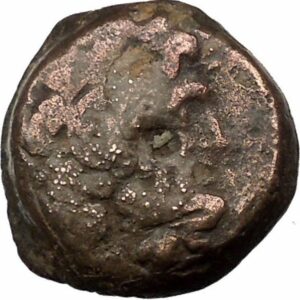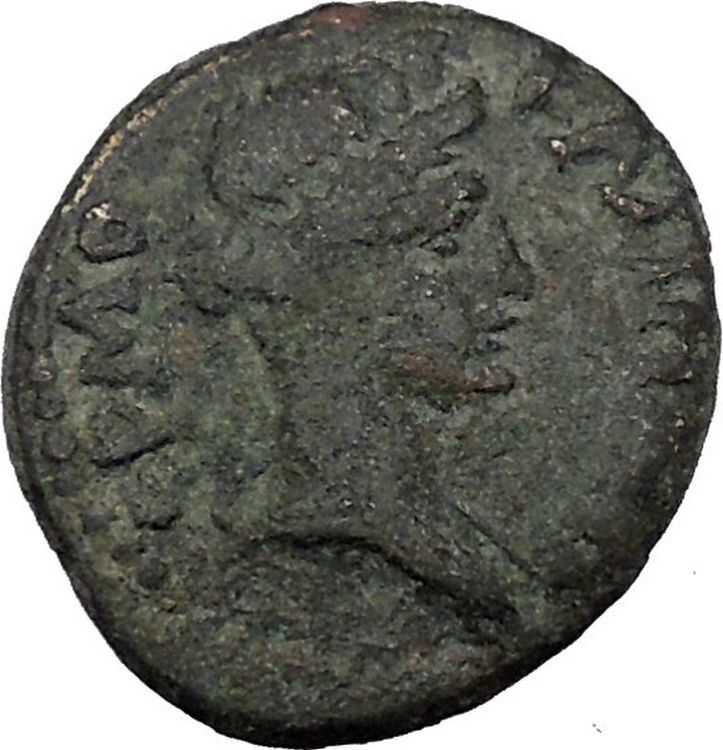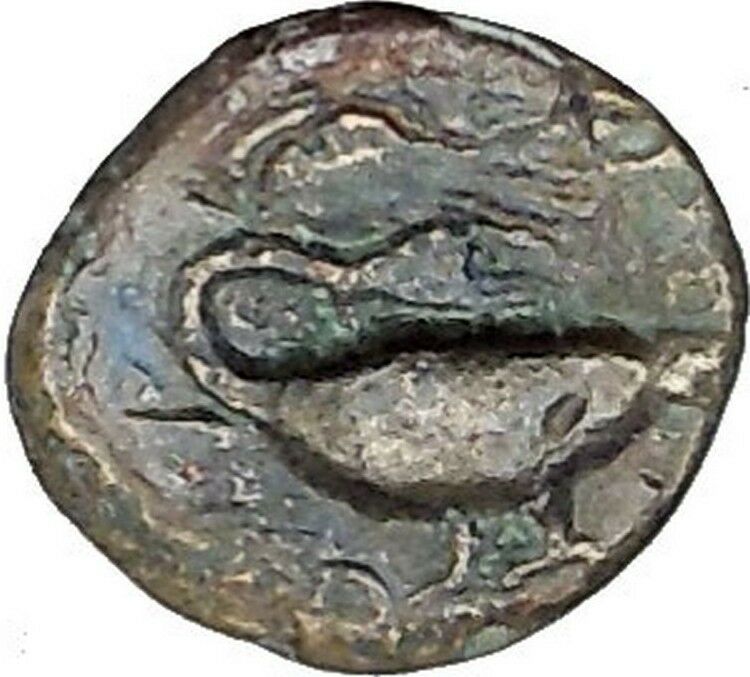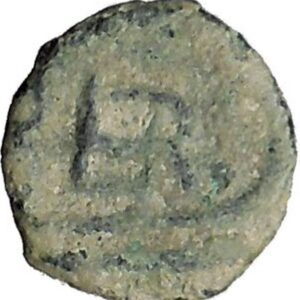|
Greek city of Apollonia Pontika
in the
Black Sea Area
Thrace
Bronze 16mm (4.47 grams) Struck 3rd-2nd centuries B.C.
Reference: SNG BM Black Sea 188-189.
Apollo seated left on omphalos, holding bow.
MYZ, Anchor, crayfish to right, A to left.
This coin may feature the famous
statue from the city.
A colony of Miletos, the city boasted
a fine temple of Apollo with a statue by the sculptor
Kalamis.
You
are bidding on the exact item pictured, provided with a
Certificate of Authenticity and Lifetime Guarantee of
Authenticity.

In
Greek
and
Roman mythology
,
Apollo,
is one of the most important and diverse of the
Olympian deities
. The
ideal of the
kouros
(a beardless
youth), Apollo has been variously recognized as a god of
light and the sun; truth and prophecy;
archery
; medicine and
healing; music, poetry, and the arts; and more. Apollo
is the son of
Zeus
and
Leto
, and has a
twin
sister, the chaste
huntress
Artemis
. Apollo is
known in Greek-influenced
Etruscan mythology
as
Apulu. Apollo was worshiped in both
ancient Greek
and
Roman religion
, as well
as in the modern
Greco
–Roman
Neopaganism
.
As the patron of
Delphi
(Pythian
Apollo), Apollo was an
oracular
god — the
prophetic deity of the
Delphic Oracle
.
Medicine and healing were associated with Apollo,
whether through the god himself or mediated through his
son
Asclepius
, yet Apollo
was also seen as a god who could bring ill-health and
deadly
plague
as well as one
who had the ability to cure. Amongst the god’s custodial
charges, Apollo became associated with dominion over
colonists
, and as the
patron defender of herds and flocks. As the leader of
the
Muses
(Apollon
Musagetes) and director of their choir, Apollo
functioned as the patron god of music and
poetry
.
Hermes
created the
lyre
for him, and the
instrument became a common
attribute
of Apollo.
Hymns sung to Apollo were called
paeans
.
In Hellenistic times, especially during the third
century BCE, as Apollo Helios he became
identified among Greeks with
Helios
,
god of the sun
, and his
sister Artemis similarly equated with
Selene
,
goddess of the moon
. In
Latin texts, on the other hand, Joseph Fontenrose
declared himself unable to find any conflation of Apollo
with
Sol
among the
Augustan poets
of the
first century, not even in the conjurations of
Aeneas
and
Latinus
in
Aeneid
XII
(161–215). Apollo and Helios/Sol remained separate
beings in literary and mythological texts until the
third century CE.
An omphalos (ὀμφαλός) is a religious stone
artifact
, or
baetylus
. In
Greek
, the word
omphalos means “navel“.
In Greek lore,
Zeus
sent two eagles
across the world to meet at its center, the “navel” of
the world. Omphalos stones marking the centre were
erected in several places about the
Mediterranean Sea
; the
most famous of those was at
Delphi
. Omphalos is
also the name of the stone given to
Cronus
. In the ancient
world of the Mediterranean, it was a powerful religious
symbol. Omphalos Syndrome refers to the misguided
belief that a place of geopolitical power and currency
is the most important place in the world.
The omphalos was not only an object of pagan
religious symbolism and world centrality; it an also one
of power. Its symbolic references included the
uterus
, the
phallus
, and a cup of
red wine representing royal blood lines. It may also
have connections to the
Holy Grail
and the
Arthurian
Sword in the Stone
.
Delphi

The omphalos in museum of
Delphi
.
Most accounts locate the Delphi omphalos in the
adyton
(sacred part of
the temple) near the
Pythia
(oracle). The
stone sculpture itself (which may be a copy), has a
carving of a knotted net covering its surface, and a
hollow center, widening towards the base. The omphalos
represents the stone which
Rhea
wrapped in
swaddling clothes, pretending it was Zeus, in order to
deceive
Cronus
. (Cronus was the
father who swallowed his children so as to prevent them
from usurping him as he had deposed his own father,
Uranus
).
Omphalos stones were believed to allow direct
communication with the gods. Holland (1933) suggested
that the stone was hollow to allow intoxicating vapours
breathed by the Oracle to channel through it.
Erwin Rohde
wrote that
the
Python
at Delphi was an
earth spirit, who was conquered by
Apollo
and buried under
the Omphalos. However, understanding of the use of the
omphalos is uncertain due to destruction of the site by
Theodosius I
and
Arcadius
in the 4th
century CE.
Jerusalem
The omphalos at the
Church of the Holy Sepulchre
,
Jerusalem, represents, in Christian mediaeval tradition,
the navel of the world (the spiritual and
cosmological centre of the world). Jewish tradition held
that God revealed himself to His people through the
Ark of the Covenant
in
the
Temple in Jerusalem
,
which rested on the
Foundation stone
marking the centre of the world. This tradition may have
stemmed from the similar one at Delphi.
Sozopol (Bulgarian:
Созопол) is an
ancient town and seaside resort located 35
km
south of
Burgas
on the southern
Black Sea Coast
of
Bulgaria
. Today the town is mostly a seaside resort
known for the Apollonia art and film festival
(which takes place in early September) and is named
after one of Sozopol’s ancient names.
The busiest times of the year are the summer months,
ranging from May to September as tourists from around
the world come to enjoy the weather, sandy beaches,
history and culture, fusion cuisine (Bulgarian, Greek,
Turkish), and atmosphere of the colourful resort. The
increasing popularity of the town has led to it being
dubbed the Bulgarian
St. Tropez
, seeing stars like
Ralph Fiennes
,
Brad Pitt
,
Angelina Jolie
and
Goldfrapp
exploring its beauty and charm.
Part of
Burgas Province
, as of September 2005[update]
Sozopol has a population of 4,641. The town is located
at
 42.417°N 42.417°N
27.7°E /
42.417; 27.7
/ 42°25′N
27°42′E
and the mayor is Panaiot Reyzi. One of the most active
and popular mayors had been
Nikola Kaloyanov
, who initiated numerous
infrastructure changes to modernize the town in the 70s.
//
History
Sozopol is one of the oldest towns on
Bulgarian Thrace
‘s
Black Sea
coast. The first settlement on the site
dates back to the
Bronze Age
. Undersea explorations in the region of
the port reveal relics of dwellings, ceramic pottery,
stone and bone tools from that era. Many anchors from
the second and first millennium BC have been discovered
in the town’s bay, a proof of active shipping since
ancient times.
The town, at first called Antheia, was
colonized in Thrace on the shore of the Pontus Euxinus,
principally on a little island, by
Anaximander
(born 610-609 BC) at the head of
Milesian
colonists. The name was soon changed to
Apollonia, on account of a temple dedicated to
Apollo
in the town, containing a famous colossal
statue of the god Apollo by
Calamis
, 30 cubits high, transported later to Rome
by
Lucullus
and placed in the
Capitol
. At various times, Apollonia was known as
Apollonia Pontica (that is, Apollonia on the
Black Sea, the ancient Pontus Euxinus) and
Apollonia Magna (Great Apollonia).
The coins, which begin in the fourth century BC, bear
the name Apollonia and the image of Apollo; the imperial
coins, which continue to the first half of the third
century AD, and the
Tabula Peutinger
also contain the name Apollonia;
but the “Periplus
Ponti Euxini“, 85, and the
Notitiæ episcopatuum
have only the new name
Sozopolis. In 1328 Cantacuzene (ed. Bonn, I, 326) speaks
of it as a large and populous town. The islet on which
it stood is now connected with the mainland by a narrow
tongue of land. Sozopolis, in Greek Sozòpolis (Σωζωπολις,
meaning the “preserve” city), in Turkish Sizebolu,
in Bulgarian Sozopol, is in Burgas Province,
Bulgaria. Its inhabitants, in the past mostly Greeks,
lived by fishing and agriculture.
The town established itself as a trade and naval
centre in the following centuries. It kept strong
political and trade relations with the cities of
Ancient Greece
–
Miletus
,
Athens
,
Corinth
,
Heraclea Pontica
and the islands
Rhodes
,
Chios
,
Lesbos
, etc. Its trade influence in the
Thracian territories
was based on a treaty with the
rulers of the
Odrysian kingdom
dating from the fifth century BC.
The symbol of the town – the anchor, present on all
coins minted by Apollonia since the sixth century BC, is
proof of the importance of its maritime trade. The rich
town soon became an important cultural centre. At these
times it was called Apollonia Magna.
Ruled in turn by the
Byzantine
,
Bulgarian
and
Ottoman
Empires, Sozopol was assigned to the newly
independent Bulgaria in the 19th century. Almost all of
its
Greek population
was exchanged
with Bulgarians from
Eastern Thrace
in the aftermath of the
Balkan Wars
.
Ecclesiastical
history
Sozopol was Christianized early. Bishops are recorded
as resident there from at least 431. At least eight
bishops are known (Le
Quien, Oriens christianus, I, 1181):
Athanasius (431), Peter (680), Euthymius (787) and
Ignatius (869); Theodosius (1357), Joannicius, who
became
Patriarch of Constantinople
(1524), Philotheus
(1564) and Joasaph (1721).
From being
suffragan
to the
archbishopric of Adrianopolis
, it became in the
fourteenth century a
metropolis
without suffragan sees; it disappeared
perhaps temporarily with the Turkish conquest, but
reappeared later; in 1808 it was united to the See of
Agathopolis
. The titular resided at
Agathopolis
, in Ottoman days called Akhtébolou, in
the
vilayet
of
Adrianopolis
(Edirne, in European Turkey).
Eubel
(Hierarchia catholica medii ævi, I,
194) mentions four Latin bishops of the fourteenth
century.
The city remains a
titular see
of the Roman Catholic Church, that of
Sozopolis in Haemimonto, suffragan of Adrianopolis.
The seat has stood vacant since the death of the last
titular bishop in 2000.[2]
Art flourished in the Christian era. The ancient
icons and magnificent woodcarving in the
iconostases
are a remarkable accomplishment of the
craftsmanship of these times. The architecture of the
houses in the old town from the
Renaissance period
makes it a unique place to visit
today.
Names
The original name of the city is attested as
Antheia.[3]
Coins were minted in the town bearing the inscription
Apollonia, which date from the sixth century BC to the
first half of the third century AD. During this period,
appellations such as Apollonia Pontica (Apollonia
on the Black Sea) and Apollonia Magna (Great
Apollonia) have been recorded. By the first century
AD, the name Sozopolis began to appear in written
records (e.g., in the
Periplus Ponti Euxini
). After the town became
part of the Ottoman Empire, the name was Turkified to
Sizeboli, Sizebolu or Sizebolou. After
Bulgaria took possession of the town, it was Slavicized
to Sozopol.
Sozopol Gap
on
Livingston Island
in the
South Shetland Islands
,
Antarctica
is named after Sozopol.
|











